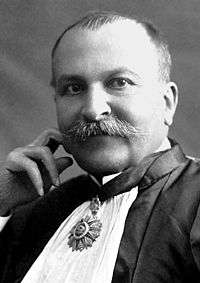Paul Sabatier (chemist)
| Paul Sabatier | |
|---|---|
|
Paul Sabatier | |
| Born |
5 November 1854 Carcassonne, France |
| Died |
14 August 1941 (aged 86) Toulouse, France |
| Nationality | French |
| Fields | Inorganic chemistry |
| Institutions |
Collège de France University of Bordeaux University of Toulouse |
| Alma mater |
Collège de France University of Paris |
| Doctoral advisor | Marcellin Berthelot |
| Known for | Heterogeneous catalysis |
| Notable awards |
Nobel Prize for Chemistry (1912) Davy Medal (1915) Albert Medal (1926) Franklin Medal (1933) |
Paul Sabatier FRS[1] (French: [sabatje]; 5 November 1854 – 14 August 1941) was a French chemist, born in Carcassonne. In 1912, Sabatier was awarded the Nobel Prize in Chemistry along with Victor Grignard. Sabatier was honoured specifically for his work improving the hydrogenation of organic species in the presence of metals.
Education
Sabatier studied at the École normale supérieure, starting in 1874. Three years later, he graduated at the top of his class.[2] In 1880, he was awarded the degree, Doctor of Science from the University of Paris.[2] He taught science classes most of his life before he became Dean of the Faculty of Science at the University of Toulouse in 1905.
Research
Sabatier's earliest research concerned the thermochemistry of sulfur and metallic sulfates, the subject for the thesis leading to his doctorate. In Toulouse, he continued his physical and chemical investigations to sulfides, chlorides, chromates and copper compounds. He also studied the oxides of nitrogen and nitrosodisulfonic acid and its salts and carried out fundamental research on partition coefficients and absorption spectra. Sabatier greatly facilitated the industrial use of hydrogenation. In 1897, building on the recent biochemical work of the American chemist, James Boyce, he discovered that the introduction of a trace amount of nickel (as a catalyst) facilitated the addition of hydrogen to molecules of most carbon compounds.
Sabatier is best known for the Sabatier process and his works such as La Catalyse en Chimie Organique (Catalysis in organic chemistry) which was published in 1913. He won the Nobel Prize in Chemistry jointly with fellow Frenchman Victor Grignard in 1912.[2] He is also known for the Sabatier principle of catalysis.
Personal life
Sabatier was married with four daughters, one of whom wed the famous Italian chemist Emilio Pomilio.[2]
The Paul Sabatier University in Toulouse is named in honor of Paul Sabatier. Paul Sabatier was a co-founder of the Annales de la Faculté des Sciences de Toulouse, together with the mathematician Thomas Joannes Stieltjes.
See also
References
- ↑ Rideal, E. K. (1942). "Paul Sabatier. 1859-1941". Obituary Notices of Fellows of the Royal Society. 4 (11): 63–26. doi:10.1098/rsbm.1942.0006.
- 1 2 3 4 "Paul Sabatier - Biography". The Nobel Foundation. Retrieved 2013-12-07.
External links
- "Paul Sabatier (to 150th anniversary of his birthday)". Russian Journal of Applied Chemistry. 77 (11): 1909–1912. 2004. doi:10.1007/s11167-005-0190-6.
- Rideal, E. K. (1951). "Presidential address. Concepts in catalysis. The contributions of Paul Sabatier and of Max Bodenstein". Journal of the Chemical Society (Resumed): 1640–1647. doi:10.1039/JR9510001640.
- Taylor, H. (1944). "Paul Sabatier 1854–1941". Journal of the American Chemical Society. 66 (10): 1615–1617. doi:10.1021/ja01238a600.
- Nobel Lecture The Method of Direct Hydrogenation by Catalysis from Nobelprize.org website

